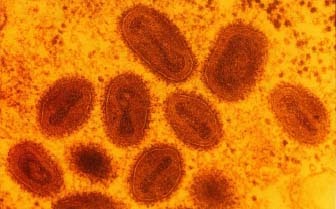Smallpox
Smallpox is a highly infectious and often fatal viral disease that leaves permanent pits in the skin. Before smallpox was wiped out, it killed, disfigured, and blinded millions of people.
KEYWORDS
for searching the Internet and other reference sources
Infectious disease
Viral Infection
A Different Kind of War
Beginning in 1966, the World Health Organization declared war against an enemy that throughout history had caused governments to fall and wiped out entire populations. The allies in this battle were mostly ordinary people in villages and towns, and their main weapon was a vaccine. Ten years later, they achieved one of the finest victories in the history of medicine: the global destruction of smallpox. The last known outbreak of the disease, which killed 2 million people in 1967, was in Somalia in 1977. In 1980, the World Health Assembly declared the world free of smallpox. Today people have nothing to fear from this disease.
Edward Jenner
Edward Jenner was born in England in 1749. He worked as a country doctor. In Europe, it was believed that milkmaids who developed cowpox (a disease that affects the udders of cows but is harmless to humans) did not get smallpox. To test this belief, in 1796 Jenner began inoculating (i-NOK-yoo-layt-ing) people with cowpox virus. In an experiment that would not be permitted today because it would be considered too dangerous, he later injected these same people with smallpox virus. They remained disease-free. Jenner's experiment with cowpox proved the value of vaccination and led to its widespread use. Modern immunology, that is, the study of how organisms fight infection, began with Jenner.
What Is Smallpox?
Smallpox is an infection caused by the variola virus. The virus was spread when one person breathed in droplets from the air that an infected person had breathed out, for instance by sneezing or coughing. It could also be spread by simply touching someone with the disease. Once inside the

What Causes Smallpox?
Social factors played a major role in the transmission of smallpox. Because it spread by face-to-face contact with another person, it thrived in the crowded conditions of poverty. Smallpox is highly infectious, but it is not as contagious as measles or the flu. If the virus ran out of humans to infect, it could not spread. However, the lesions that appeared on the skin as the disease progressed were infectious and could contaminate nonliving objects such as clothes or blankets for long periods. Children, the elderly, and people who were sick from other diseases would catch smallpox more easily, but the virus could infect anyone.
What Are the Symptoms of Smallpox?
Smallpox would begin very suddenly, and in the beginning it was like a bad case of the flu. After a few days, the flu-like symptoms went away, and the skin broke out in bumps. At first the bumps were solid, but soon they became filled with liquid, like blisters, and then with pus. Finally, after about 2 weeks, the blisters dried up and formed scabs. When the scabs fell off, they left permanent pits in the skin, most often on the face. Many people who developed this form of smallpox recovered. However, in severe cases, where a high fever and bleeding rash were present, a person might have died in a few days.
Should the Smallpox
Virus Be Destroyed?
As of 1999, the smallpox virus officially remained only in two high-security laboratories in Atlanta and Moscow. These "stocks" of the virus were kept because they have value for scientific research. But some people argue that they should be destroyed because the damage the virus would cause if it were ever released would pose too great a risk. The World Health Organization fixed the date of June 30,1999, to destroy the remaining stocks of smallpox, but then changed its mind because of the strong debate in the scientific community. Scientists argue that a future smallpox epidemic could occur, and without these stored viruses, newer vaccines and antiviral drugs could not be made. They say that stored vaccines are old and deteriorating. Also, the old vaccine is a live virus that could not be given to people who have impaired immune systems or who have had organ transplants. The virus itself might be needed to develop effective vaccines for these people.
How Did Doctors Diagnose Smallpox?
Before smallpox was wiped out, it was easy to tell whether people had the disease simply by their appearance. Sometimes, the initial fever might have been mistaken for the flu. Or the rash might have been confused

How Was Smallpox Treated?
In the past, treatment for smallpox was aimed at making patients comfortable and limiting the spread of the disease. If possible, patients were separated from other people, and the area around them and the things they touched were kept very clean to prevent further infection.
Vaccination Prevents Smallpox
Hundreds of years ago, in Asia, it was observed that people who survived smallpox never got it again. This observation led to a practice later called variolation (var-ee-o-LAY-shun), which involved, for example, rubbing pus from a smallpox lesion into small scratches or cuts in the skin of healthy people in the hope of protecting them. Although these people still developed smallpox, it was often a mild form.
Variolation was unknown in Europe and North America until the 1700s. In 1796, Edward Jenner showed that variolation using cowpox instead of smallpox could protect a person completely from the disease, sparing the person from even a minor case of smallpox. Jenner's vaccine (from the Latin word for "cow") made it possible to control smallpox in many countries. But it was only in 1980 that enough people around the world had been vaccinated to stop the disease forever.
In the past, children were routinely immunized against smallpox before their first birthday. But now that smallpox has been wiped out, vaccination is no longer necessary.
What Are Viruses?
Viruses are organisms that are smaller than cells, so tiny that they can be seen only with a special kind of microscope. To multiply and cause disease, viruses need the help of a living cell. Although viral particles may be present in large numbers, some viruses can remain in the body for a long time, even many years, before people begin to feel sick. The AIDS (acquired immune deficiency syndrome) virus is a good example of this kind of virus. Other viruses, like influenza or smallpox, make people ill very quickly.
Resources
Books
Giblion, James Cross, and David Frampton. When Plague Strikes: The Black Death, Smallpox, AIDS. New York: HarperCollins, 1995.
Goodfield, June. Quest for the Killers. Boston: Birkhauser, 1985, pp. 191-244.
McNeill, William H. Plagues and Peoples. Garden City, NY: Anchor Books, 1989.
Article
Henderson, David A. The Eradication of Smallpox. Scientific American, 1976, Vol. 235, pp. 25-33.
Tutorial
"A Dose of the Pox," a self-teaching guide about smallpox
and Edward Jenner's vaccine.
http://www-micro.msb.le.ac.uk/Tutorials/Pox/Pox1.html
Organizations
World Health Organization (WHO), Avenue Appia 20, 1211 Geneva 27,
Switzerland. The WHO led the campaign to eradicate smallpox. Their Web
site provides information about public health around the world.
http://www.who.org
Centers for Disease Control and Prevention (CDC), 1600 Clifton Road,
N.E., Atlanta, GA 30333. The United States government authority for
information about infectious and other diseases.
http://www.cdc.gov
Comment about this article, ask questions, or add new information about this topic: